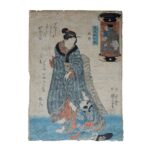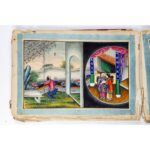Japanese woodblock print or Ukiyo-eParody of the Chushingura in Lanterns – Prologue
The prologue of the series Chūshingura Parody on Lanterns (Mitate chōchingura 見立挑灯蔵), which accompany the play Kanadehon chūshingura 仮名手本忠臣蔵 or Treasury of Faithful Servants. It is a famous story about bushido, (Jp. bushido 武士道) the samurai code of chivalry, and loyalty, in which 47 masterless samurai (ronin, Jap. rōnin 浪人) seek revenge for the death of their master.
The image shows a woman wearing a blue kimono patterned with chrysanthemums and paulownia, and a green sash, the obi 帯. On the belt are patterns of snowy pine, plum blossoms, and bamboo leaves. On the inner collar of the red under-kimono is a pattern in shibori technique. The collar of the blue kimono is black with a pine needle pattern. In her right hand, the woman holds an origami in the shape of a helmet, called kabuto 兜, and looks at a child, who holds on to her kimono. The child ... more
The prologue of the series Chūshingura Parody on Lanterns (Mitate chōchingura 見立挑灯蔵), which accompany the play Kanadehon chūshingura 仮名手本忠臣蔵 or Treasury of Faithful Servants. It is a famous story about bushido, (Jp. bushido 武士道) the samurai code of chivalry, and loyalty, in which 47 masterless samurai (ronin, Jap. rōnin 浪人) seek revenge for the death of their master.
The image shows a woman wearing a blue kimono patterned with chrysanthemums and paulownia, and a green sash, the obi 帯. On the belt are patterns of snowy pine, plum blossoms, and bamboo leaves. On the inner collar of the red under-kimono is a pattern in shibori technique. The collar of the blue kimono is black with a pine needle pattern. In her right hand, the woman holds an origami in the shape of a helmet, called kabuto 兜, and looks at a child, who holds on to her kimono. The child is also wearing a blue kimono with a pattern of water nut leaves and Japanese quince blossoms.
The poem on the print reads: “A young girl with a hairpin in the shape of a gourd vine stuck in her hair, smelling of incense from Tsurugaoka” (Umeya). This refers both to the depicted beauty and to the masterless samurai (ronin 浪人) depicted on the lantern. (KH, JR)




































Do you have a comment or additional information about the subject?